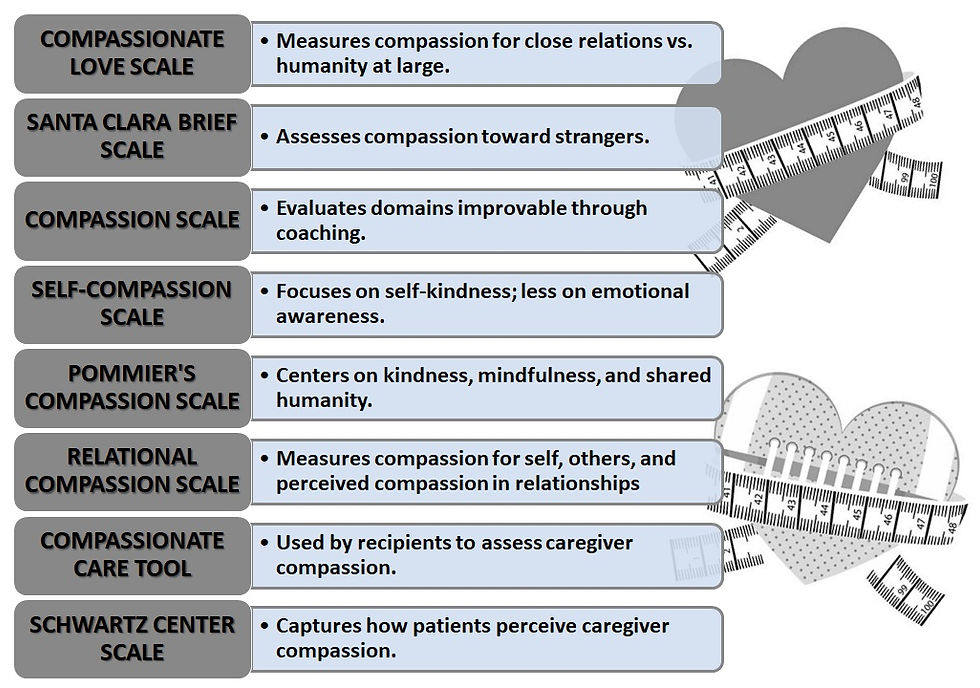COMPASSION TRAINING: HOW TO BUILD RESILIENCE, EMPATHY, AND EMOTIONAL STRENGTH
- shoury01
- Jul 1, 2025
- 7 min read
Discussion - what compassion training is, how it rewires the brain, and explore proven techniques to boost empathy, emotional resilience, and mental well-being daily.

What is Compassion Training?
Compassion is an ever-growing area of interest within psychology and psychotherapy. Definitions of compassion within psychology are varied and divergent, with some researchers considering it to be an emotion, a biologically based characteristic, or a multidimensional construct. There is, however, a broad agreement that compassion is comprised of a combination of affective, cognitive, and motivational components. A simple statement is that compassion is a concern for the wellbeing of others. A panel of researchers in 2012 defined compassion as a complex multidimensional construct comprised of four components:

Differentiating Compassion From Related Emotions
Compassion is often misunderstood and easily confused with other related but distinct constructs. While it is important to define compassion, it is equally important to define what it is not. Some of these differing constructs are:
Empathy: . . . . . . . . . . Unlike compassion, empathy does not incorporate the readiness to act in order to relieve the suffering of others, rather it is the ability to understand another’s feelings and become one with that person’s distress. Empathy is described as the capacity to be affected by and share the emotional state of another and identify with the other, adopting his or her perspective.
Sympathy: . . . . . . . . . . . . Similarly, sympathy is the experience of feeling sorrow for someone else’s misfortune but not necessarily a shared perspective or shared emotions. With compassion, there is recognition of the other person’s emotional state and a desire to act in order to help.

Pity: . . . . . . . . . . . . Pity refers more to feeling concern for someone thought to be inferior or weaker than oneself and is by definition, rooted in a hierarchical sense of superiority over someone else. Compassion, on the other hand, does not consider the object of suffering to be weak or inferior in any way. Instead, it encourages a broader vision through common experiences.
Altruism: . . . . . . . . . . . . Altruism is acting out of concern for another person’s well-being, while compassion encapsulates an openness to experiencing suffering and responding with genuine concern, and without judgment. Compassion can exist in the absence of altruistic behavior.
Love: . . . . . . . . . . . . Compassion is functionally distinct from the two most common forms of love; romantic love and the love of a parent for a child. The fundamental difference between the two is that compassion likely involves a complex combination of multiple positive and negative emotions. Where love is generally associated with positive affect and experiences only, compassion is about being open to the experience of suffering.

The Three Orientations of Compassion
Psychological investigations of compassion have primarily focused on three specific orientations of compassion. They are:
Receiving Compassion: . . . . . . . . . The feeling like one does not deserve kindness from others, can create a fear of receiving compassion. Improving this orientation of compassion may enhance relationships and social connectedness by coaching individuals to become more comfortable being the object of another person’s attention.
Self-Compassion: . . . . . . . . . . Self-compassion positively affects coping skills, life satisfaction, emotional intelligence, social connectedness, mastery of goals, personal initiative, curiosity, wisdom, happiness, optimism, and positive affect. A key component of self-compassion is the absence of self-criticism, which is known to be an early predictor of anxiety and depression. Self-compassionate people tend to recognize that imperfection and failure are often unavoidable, and so are more likely to be kind to themselves when confronted with negative experiences.
Compassion for Others: . . . . . . . . . . Compassion for others is not always expressed and can actually be suppressed or inhibited. It was initially thought that self-compassion and compassion for others may be related given they have the same theoretical structure and base definition. Research has, indicated that the two may be different because:
1) Compassion is directed towards others as opposed to the self.
2) Individuals are often more compassionate to others than they are themselves.
Can Compassion Be Learned?
Compassion can be adopted at any age and involves training the mind to develop specific skills in order to relate to others and to ourselves, and making a conscious effort to think and act in a compassionate manner. While everyone has, to some degree, a level of compassion, for some it can be beneficial to develop these skills further.
Much of the emphasis within compassion-based training is on stimulating a more compassionate social mentality. Compassion-based training works by activating affiliative processing systems in the brain. These processing systems include the myelinated parasympathetic nervous system which helps in the regulation of our fight/flight response.

Activation of the parasympathetic system when under a perceived threat encourages a feeling of safeness and security, and allows for mentalization, that is the ability to understand our own mental state.
Compassion training focuses not only on suffering but also on supporting and encouraging compassion for the good of the self and others. Through a range of breathing, postural, imaging techniques and developing recall skills that enable the recall of experiencing compassion, individuals are given the opportunity to experience what compassion is, or could be. In essence, compassion training helps to create ideas in the mind about what can be achieved. With positive effects on mental health, emotion regulation, and interpersonal and social relationships, it is clear that developing compassion can have significant and far-reaching benefits.
How Can We Best Cultivate Compassion?
A growing body of evidence suggests that, at our core, most humans have a natural capacity for compassion. Infants too young to have learned the rules of politeness spontaneously engaged in helpful behaviour without a promise of reward, and would even overcome obstacles to do so. Despite this, everyday stress, social pressures and life experiences, in general, can make it difficult to experience and fully express compassion to ourselves and to others. Fortunately, we also have the capacity to nurture and cultivate a more compassionate outlook.

Cultivating compassion is more than experiencing empathy or concern for others. It develops the strength to cope with suffering, to take compassionate action, and the resilience to prevent compassion fatigue – an extreme state of tension and preoccupation with the suffering of others. These qualities support a wide range of goals, from improving personal relationships to making a positive difference in the world.
There are at least six current empirically-supported interventions that focus on the cultivation of compassion:
A) Compassion-Focused Therapy: . . . . . . . . . . This focuses on two psychologies of compassion. The first is a motivation to engage with suffering, and the second is focused on action, specifically acting to help alleviate and prevent suffering. It is an integrated and multi-modal approach concerned with alleviating the sense of shame and high levels of self-criticism we often experience.
B) Mindful Self-Compassion: . . . . . . . . . . This was developed as a program to help cultivate self-compassion, that is treating ourselves with the same kindness, concern, and support we would show to a good friend. This combines the skills of mindfulness and self-compassion to enhance our capacity for emotional well-being. Its emphasis is on distinguishing between the inner critic and compassionate-self.
C) Compassion Cultivation Training: . . . . . . . . . . It draws its theoretical underpinnings from contemplative practices of Tibetan Buddhism and Western psychology. It delivers training in compassion practices across six steps:

D) Cognitively-Based Compassion Training: . . . . . . . . . . This draws from what is known as ‘lojong’ in Indo-Tibetan Buddhism and coaches practitioners to cultivate compassion through simple contemplative practices. It incorporates mindfulness and cognitive restructuring strategies to encourage a shift of perspective through reflection about ourselves and our relationship to others.
E) Cultivating Emotional Balance: . . . . . . . . . . This is based on Western scientific research on emotions, and traditional Eastern contemplative practices and is aimed at building emotional balance. Here there is an emphasis on understanding emotions and being able to recognize the emotions of others. It is an educational training method that creates pathways to compassion by training and teaching individuals to recognize the suffering of others and of oneself, and to tolerate the distress more effectively through learning new ways of managing emotions.
F) Compassion Meditations and Loving-Kindness Meditations: . . . . . . . . . .These are often combined and practiced together in compassion-based interventions to help settle the mind, increase compassion to self and others, and to improve mental health. They are meditations during which the aim is to express goodwill, kindness, and warmth towards others by silently repeating a series of mantras. Both practices involve a structured approach where individuals can learn to direct caring feelings towards oneself, then towards loved ones, then towards acquaintances, then towards strangers, then towards someone with whom one experiences interpersonal difficulties, and finally towards all living beings without distinction.

Can Compassion Be Measured?
Eight popular psychometric instruments that are used in the measurement of compassion are mentioned below. Each has its own varying validity and focuses on different aspects of compassion.

Real-World Examples
Healthcare Workers: During the COVID-19 crisis, many used compassion training and mindfulness to avoid burnout and care for patients effectively.
Corporate Leaders: Companies like Microsoft now include empathy training as a core part of leadership development.
Ways to Build and Cultivate Compassion in Daily Routines
The aim of these exercises and activities is to cultivate compassion in whatever state you currently occupy. Commonalities – Rather than focusing on how we differ from others, we can try instead to recognize what we have in common. Reflect on the commonalities we have with everyone else – we are all connected to the larger human experience.

The Eastern wisdom practice of Tonglen – take a moment to imagine all the people in the world who may be struggling in the same way that we are. Inhale and think of how we are experiencing the same feelings as others are. Exhale and focus on the compassion we feel both for ourselves and for others.
Conclusion: Why Compassion Is a Modern Necessity
We all have the potential to become more compassionate—to ourselves, to others, and to the world. With consistent practice and the right tools, compassion becomes not just an occasional response, but a way of being. In times of crisis, division, or even day-to-day stress, compassion isn’t a luxury. It’s a skill we can learn—and a strength we can lead with.


Content Curated By: Dr Shoury Kuttappa






Comments